Cengiz Oztireli
Multigranular Evaluation for Brain Visual Decoding
Jul 10, 2025Abstract:Existing evaluation protocols for brain visual decoding predominantly rely on coarse metrics that obscure inter-model differences, lack neuroscientific foundation, and fail to capture fine-grained visual distinctions. To address these limitations, we introduce BASIC, a unified, multigranular evaluation framework that jointly quantifies structural fidelity, inferential alignment, and contextual coherence between decoded and ground truth images. For the structural level, we introduce a hierarchical suite of segmentation-based metrics, including foreground, semantic, instance, and component masks, anchored in granularity-aware correspondence across mask structures. For the semantic level, we extract structured scene representations encompassing objects, attributes, and relationships using multimodal large language models, enabling detailed, scalable, and context-rich comparisons with ground-truth stimuli. We benchmark a diverse set of visual decoding methods across multiple stimulus-neuroimaging datasets within this unified evaluation framework. Together, these criteria provide a more discriminative, interpretable, and comprehensive foundation for measuring brain visual decoding methods.
Restereo: Diffusion stereo video generation and restoration
Jun 06, 2025Abstract:Stereo video generation has been gaining increasing attention with recent advancements in video diffusion models. However, most existing methods focus on generating 3D stereoscopic videos from monocular 2D videos. These approaches typically assume that the input monocular video is of high quality, making the task primarily about inpainting occluded regions in the warped video while preserving disoccluded areas. In this paper, we introduce a new pipeline that not only generates stereo videos but also enhances both left-view and right-view videos consistently with a single model. Our approach achieves this by fine-tuning the model on degraded data for restoration, as well as conditioning the model on warped masks for consistent stereo generation. As a result, our method can be fine-tuned on a relatively small synthetic stereo video datasets and applied to low-quality real-world videos, performing both stereo video generation and restoration. Experiments demonstrate that our method outperforms existing approaches both qualitatively and quantitatively in stereo video generation from low-resolution inputs.
Exploring The Visual Feature Space for Multimodal Neural Decoding
May 21, 2025Abstract:The intrication of brain signals drives research that leverages multimodal AI to align brain modalities with visual and textual data for explainable descriptions. However, most existing studies are limited to coarse interpretations, lacking essential details on object descriptions, locations, attributes, and their relationships. This leads to imprecise and ambiguous reconstructions when using such cues for visual decoding. To address this, we analyze different choices of vision feature spaces from pre-trained visual components within Multimodal Large Language Models (MLLMs) and introduce a zero-shot multimodal brain decoding method that interacts with these models to decode across multiple levels of granularities. % To assess a model's ability to decode fine details from brain signals, we propose the Multi-Granularity Brain Detail Understanding Benchmark (MG-BrainDub). This benchmark includes two key tasks: detailed descriptions and salient question-answering, with metrics highlighting key visual elements like objects, attributes, and relationships. Our approach enhances neural decoding precision and supports more accurate neuro-decoding applications. Code will be available at https://github.com/weihaox/VINDEX.
RETRO: REthinking Tactile Representation Learning with Material PriOrs
May 20, 2025Abstract:Tactile perception is profoundly influenced by the surface properties of objects in contact. However, despite their crucial role in shaping tactile experiences, these material characteristics have been largely neglected in existing tactile representation learning methods. Most approaches primarily focus on aligning tactile data with visual or textual information, overlooking the richness of tactile feedback that comes from understanding the materials' inherent properties. In this work, we address this gap by revisiting the tactile representation learning framework and incorporating material-aware priors into the learning process. These priors, which represent pre-learned characteristics specific to different materials, allow tactile models to better capture and generalize the nuances of surface texture. Our method enables more accurate, contextually rich tactile feedback across diverse materials and textures, improving performance in real-world applications such as robotics, haptic feedback systems, and material editing.
Best Foot Forward: Robust Foot Reconstruction in-the-wild
Feb 27, 2025Abstract:Accurate 3D foot reconstruction is crucial for personalized orthotics, digital healthcare, and virtual fittings. However, existing methods struggle with incomplete scans and anatomical variations, particularly in self-scanning scenarios where user mobility is limited, making it difficult to capture areas like the arch and heel. We present a novel end-to-end pipeline that refines Structure-from-Motion (SfM) reconstruction. It first resolves scan alignment ambiguities using SE(3) canonicalization with a viewpoint prediction module, then completes missing geometry through an attention-based network trained on synthetically augmented point clouds. Our approach achieves state-of-the-art performance on reconstruction metrics while preserving clinically validated anatomical fidelity. By combining synthetic training data with learned geometric priors, we enable robust foot reconstruction under real-world capture conditions, unlocking new opportunities for mobile-based 3D scanning in healthcare and retail.
Feed-Forward Bullet-Time Reconstruction of Dynamic Scenes from Monocular Videos
Dec 04, 2024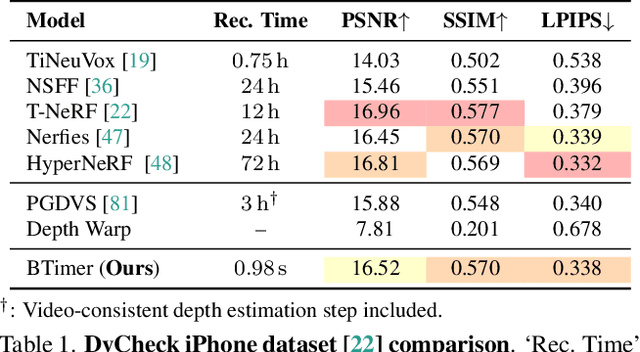
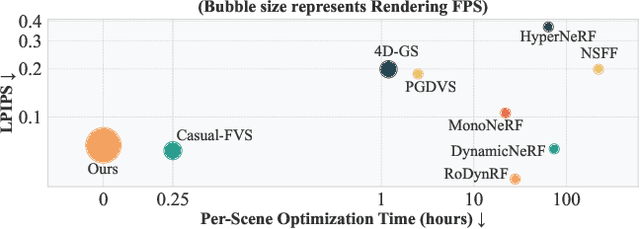
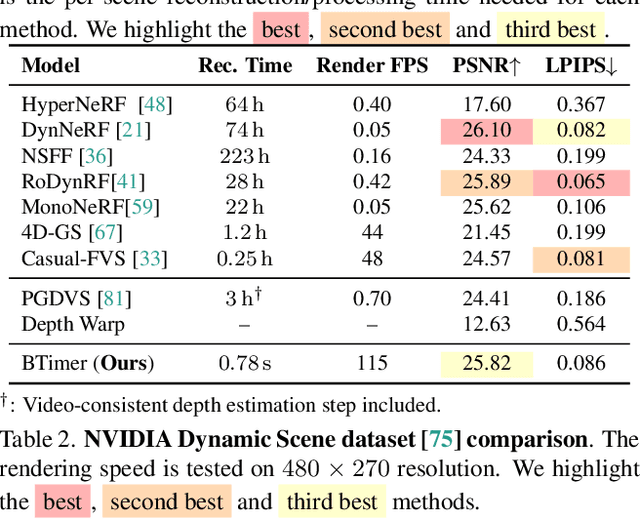
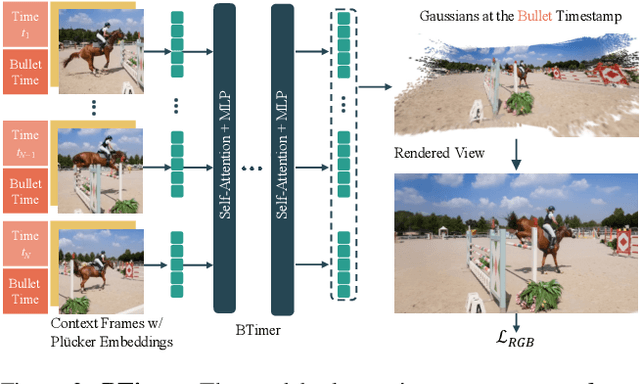
Abstract:Recent advancements in static feed-forward scene reconstruction have demonstrated significant progress in high-quality novel view synthesis. However, these models often struggle with generalizability across diverse environments and fail to effectively handle dynamic content. We present BTimer (short for BulletTimer), the first motion-aware feed-forward model for real-time reconstruction and novel view synthesis of dynamic scenes. Our approach reconstructs the full scene in a 3D Gaussian Splatting representation at a given target ('bullet') timestamp by aggregating information from all the context frames. Such a formulation allows BTimer to gain scalability and generalization by leveraging both static and dynamic scene datasets. Given a casual monocular dynamic video, BTimer reconstructs a bullet-time scene within 150ms while reaching state-of-the-art performance on both static and dynamic scene datasets, even compared with optimization-based approaches.
Physically Based Neural Bidirectional Reflectance Distribution Function
Nov 04, 2024Abstract:We introduce the physically based neural bidirectional reflectance distribution function (PBNBRDF), a novel, continuous representation for material appearance based on neural fields. Our model accurately reconstructs real-world materials while uniquely enforcing physical properties for realistic BRDFs, specifically Helmholtz reciprocity via reparametrization and energy passivity via efficient analytical integration. We conduct a systematic analysis demonstrating the benefits of adhering to these physical laws on the visual quality of reconstructed materials. Additionally, we enhance the color accuracy of neural BRDFs by introducing chromaticity enforcement supervising the norms of RGB channels. Through both qualitative and quantitative experiments on multiple databases of measured real-world BRDFs, we show that adhering to these physical constraints enables neural fields to more faithfully and stably represent the original data and achieve higher rendering quality.
SYM3D: Learning Symmetric Triplanes for Better 3D-Awareness of GANs
Jun 10, 2024



Abstract:Despite the growing success of 3D-aware GANs, which can be trained on 2D images to generate high-quality 3D assets, they still rely on multi-view images with camera annotations to synthesize sufficient details from all viewing directions. However, the scarce availability of calibrated multi-view image datasets, especially in comparison to single-view images, has limited the potential of 3D GANs. Moreover, while bypassing camera pose annotations with a camera distribution constraint reduces dependence on exact camera parameters, it still struggles to generate a consistent orientation of 3D assets. To this end, we propose SYM3D, a novel 3D-aware GAN designed to leverage the prevalent reflectional symmetry structure found in natural and man-made objects, alongside a proposed view-aware spatial attention mechanism in learning the 3D representation. We evaluate SYM3D on both synthetic (ShapeNet Chairs, Cars, and Airplanes) and real-world datasets (ABO-Chair), demonstrating its superior performance in capturing detailed geometry and texture, even when trained on only single-view images. Finally, we demonstrate the effectiveness of incorporating symmetry regularization in helping reduce artifacts in the modeling of 3D assets in the text-to-3D task.
Evolutive Rendering Models
May 27, 2024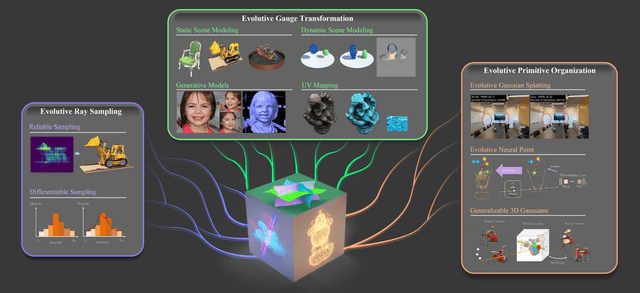
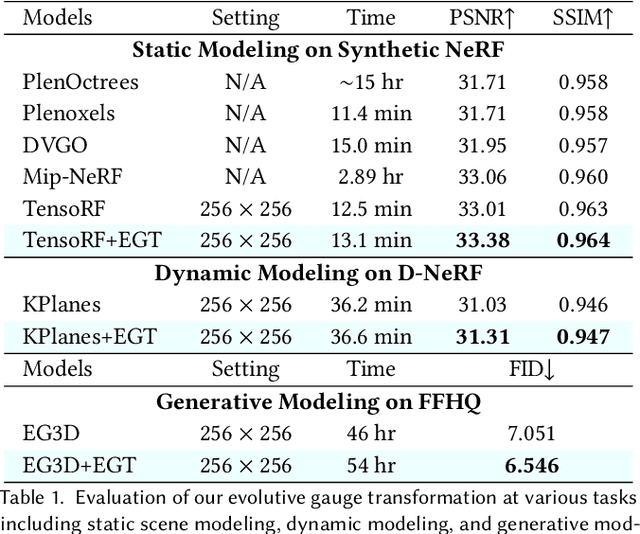
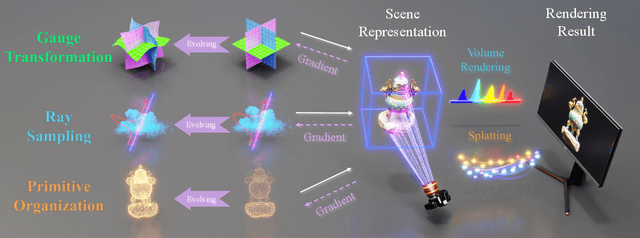

Abstract:The landscape of computer graphics has undergone significant transformations with the recent advances of differentiable rendering models. These rendering models often rely on heuristic designs that may not fully align with the final rendering objectives. We address this gap by pioneering \textit{evolutive rendering models}, a methodology where rendering models possess the ability to evolve and adapt dynamically throughout the rendering process. In particular, we present a comprehensive learning framework that enables the optimization of three principal rendering elements, including the gauge transformations, the ray sampling mechanisms, and the primitive organization. Central to this framework is the development of differentiable versions of these rendering elements, allowing for effective gradient backpropagation from the final rendering objectives. A detailed analysis of gradient characteristics is performed to facilitate a stable and goal-oriented elements evolution. Our extensive experiments demonstrate the large potential of evolutive rendering models for enhancing the rendering performance across various domains, including static and dynamic scene representations, generative modeling, and texture mapping.
Gaussian Head & Shoulders: High Fidelity Neural Upper Body Avatars with Anchor Gaussian Guided Texture Warping
May 21, 2024

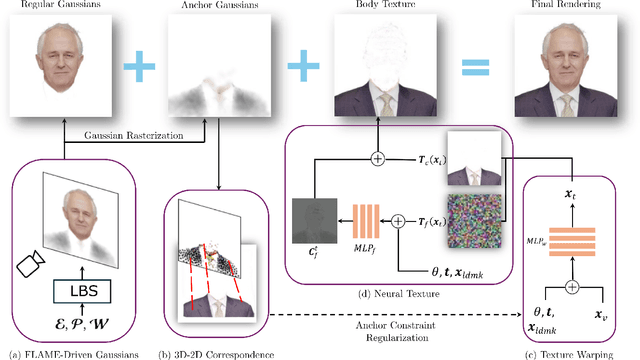

Abstract:By equipping the most recent 3D Gaussian Splatting representation with head 3D morphable models (3DMM), existing methods manage to create head avatars with high fidelity. However, most existing methods only reconstruct a head without the body, substantially limiting their application scenarios. We found that naively applying Gaussians to model the clothed chest and shoulders tends to result in blurry reconstruction and noisy floaters under novel poses. This is because of the fundamental limitation of Gaussians and point clouds -- each Gaussian or point can only have a single directional radiance without spatial variance, therefore an unnecessarily large number of them is required to represent complicated spatially varying texture, even for simple geometry. In contrast, we propose to model the body part with a neural texture that consists of coarse and pose-dependent fine colors. To properly render the body texture for each view and pose without accurate geometry nor UV mapping, we optimize another sparse set of Gaussians as anchors that constrain the neural warping field that maps image plane coordinates to the texture space. We demonstrate that Gaussian Head & Shoulders can fit the high-frequency details on the clothed upper body with high fidelity and potentially improve the accuracy and fidelity of the head region. We evaluate our method with casual phone-captured and internet videos and show our method archives superior reconstruction quality and robustness in both self and cross reenactment tasks. To fully utilize the efficient rendering speed of Gaussian splatting, we additionally propose an accelerated inference method of our trained model without Multi-Layer Perceptron (MLP) queries and reach a stable rendering speed of around 130 FPS for any subjects.
 Add to Chrome
Add to Chrome Add to Firefox
Add to Firefox Add to Edge
Add to Edge